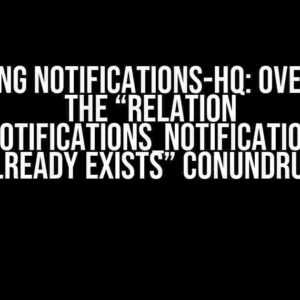Hey there, fellow developers! Are you frustrated with the mysterious 400 error that’s haunting your Feign requests after upgrading to Spring Boot 3? Don’t worry, you’re not alone! In this comprehensive guide, we’ll walk you through the possible causes, debugging techniques, and solutions to get your Feign requests up and running again.
What Changed in Spring Boot 3?
Before we dive into the troubleshooting process, let’s quickly review the changes in Spring Boot 3 that might be causing the 400 error:
- The default HTTP client has been changed from Apache HttpClient to the JDK’s built-in HTTP client.
- The deprecated
@EnableFeignClientsannotation has been removed. Instead, you need to use@EnableFeign. - The
feign.hystrix.enabledproperty has been deprecated and replaced withfeign.circuitbreaker.enabled.
Identifying the Problem
To troubleshoot the 400 error, you need to identify the root cause. Here are some common scenarios to consider:
Scenario 1: Incompatible Feign Client Configuration
If you’re using a custom Feign client configuration, it might not be compatible with the new Spring Boot 3 defaults. Check your configuration files (e.g., application.properties or application.yml) for any outdated settings.
feign:
client:
config:
default:
connect-timeout: 10000
read-timeout: 10000
logger-level: FULLIn this example, the connect-timeout and read-timeout properties might be causing issues with the new HTTP client. Try removing or updating these settings to match the Spring Boot 3 defaults.
Scenario 2: Incompatible Header or Query Parameters
Verify that your Feign client is sending compatible header or query parameters. Use tools like Postman or cURL to inspect the request and response:
curl -X GET \
'https://example.com/api/users' \
-H 'Accept: application/json' \
-H 'Content-Type: application/json'In this example, the Accept and Content-Type headers might be causing issues. Check your Feign client implementation to ensure it’s sending the correct headers.
Scenario 3: Version Incompatibilities
Check your project’s dependencies for version inconsistencies. Make sure you’re using compatible versions of Spring Boot, Feign, and other libraries:
| Library | Compatible Version |
|---|---|
| Spring Boot | 3.0.0+ |
| Feign | 11.5+ |
| OpenFeign | 11.5+ |
Update your dependencies to ensure compatibility. You can use the Spring Initializr or Maven/Gradle to manage your dependencies.
Debugging Techniques
To debug the 400 error, try the following techniques:
Enable Feign Debugging
Add the following configuration to your application properties:
feign:
debug: trueThis will enable Feign debugging, allowing you to see detailed logs of the request and response.
Use a Proxy Server
Set up a proxy server like Fiddler or Charles to inspect the request and response:
fiddler --startThis will allow you to see the exact request and response, helping you identify the issue.
Implement a Feign ErrorDecoder
Create a custom Feign error decoder to handle 400 errors:
@Component
public class CustomErrorDecoder implements ErrorDecoder {
@Override
public Exception decode(String methodKey, Response response) {
if (response.status() == 400) {
// Handle 400 error
return new BadGatewayException();
}
return new DefaultErrorDecoder().decode(methodKey, response);
}
}This will allow you to catch and handle 400 errors in a centralized way.
Solutions
Based on your debugging results, implement the following solutions:
Solution 1: Update Feign Client Configuration
If you identified incompatible Feign client configuration, update your configuration files to match the Spring Boot 3 defaults:
feign:
client:
config:
default:
connect-timeout: 5000
read-timeout: 5000
logger-level: BASICThis will ensure that your Feign client is using compatible configuration settings.
Solution 2: Fix Incompatible Header or Query Parameters
If you identified incompatible header or query parameters, update your Feign client implementation to send compatible headers:
@FeignClient(name = "user-service", url = "https://example.com/api")
public interface UserService {
@GetMapping("/users")
List<User> getUsers(@RequestHeader("Accept") String accept);
}In this example, the @RequestHeader annotation ensures that the Accept header is sent with the correct value.
Solution 3: Upgrade Dependencies
If you identified version inconsistencies, update your dependencies to ensure compatibility:
<dependency>
<groupId>org.springframework.boot</groupId>
<artifactId>spring-boot-starter-web</artifactId>
<version>3.0.0</version>
</dependency>
<dependency>
<groupId>org.openfeign</groupId>
<artifactId>feign-okhttp</artifactId>
<version>11.5</version>
</dependency>This will ensure that you’re using compatible versions of Spring Boot and Feign.
Conclusion
Troubleshooting a 400 error in Feign requests after upgrading to Spring Boot 3 can be challenging. However, by following this guide, you should be able to identify and resolve the underlying issue. Remember to:
- Review changes in Spring Boot 3
- Identify the problem scenario
- Debug using Feign debugging, proxy servers, and custom error decoders
- Implement solutions based on your debugging results
Happy coding, and don’t hesitate to reach out if you have any further questions or concerns!
Frequently Asked Question
Ever wondered what’s going on with Feign requests returning 400 errors after upgrading to Spring Boot 3? Well, you’re not alone! Here are some answers to the most pressing questions.
Why did my Feign requests start returning 400 errors after upgrading to Spring Boot 3?
The culprit is likely the new default behavior in Spring Boot 3, which now enforces stricter Header validation. This means that Feign clients might start sending headers with invalid characters, resulting in those pesky 400 errors. Don’t worry, we’ve got a fix for you!
How can I identify the problematic headers causing the 400 errors?
Enable debugging for Feign by adding the `feign.debug=true` property to your application configuration. This will allow you to see the request and response details, including the headers, in your logs. Now, go digging and find those misbehaving headers!
Can I disable the new header validation in Spring Boot 3?
Yes, you can! Add the following configuration to your application: `feign.httpclient.enabled=false` or `feign.okhttp.enabled=false`, depending on the HTTP client you’re using. This will revert to the old behavior, but keep in mind that this is not recommended as it might introduce security vulnerabilities.
What’s the recommended way to fix Feign requests returning 400 errors in Spring Boot 3?
The best approach is to update your Feign clients to correctly handle headers according to the new validation rules. This might involve tweaking your Feign configuration, updating your dependencies, or even refactoring your code. Your future self (and your users) will thank you!
Where can I find more resources on Feign and Spring Boot 3?
Head over to the official Spring Boot and Feign documentation, as well as online forums and communities like Stack Overflow and GitHub. You can also check out tutorials, blogs, and YouTube channels dedicated to Spring Boot and Feign. The more you know, the better equipped you’ll be to tackle those 400 errors!



